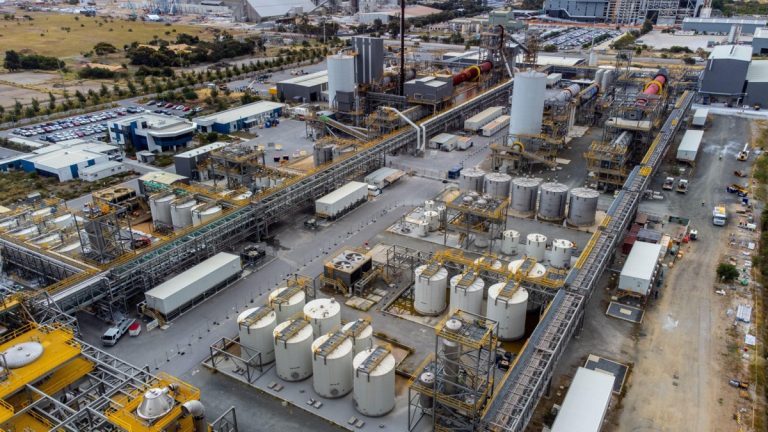
Tianqi Lithium hard rock processing plant at Kwinana Beach, Western Australia. Stock Image.
The Kemerton/ Kwinana Strategic Disaster
The three large mining groups that operate the Greenbushes Mine in Western Australia – Albemarle, Tianqi and IGO – have experienced extraordinary setbacks in their attempts to build a downstream lithium chemicals industry to process concentrate from Greenbushes and make Australia a leading producer of lithium carbonate and hydroxide. These setbacks are nothing less than a strategic and industrial disaster.
Albemarle and IGO/Tianqi have been building a pair of lithium refineries in Western Australia since 2016. In 2024 the projects definitively came off the rails. This fiasco is a Strategic and Industrial Disaster for western efforts to break Chinese dominance of downstream lithium chemical production and battery production.
Kwinana
In early 2017 Tianqi started construction of an LHM plant at Kwinana with two 24,000 tpa trains. They stated in 2018 that ultimately it would have 4 trains and be the largest LHM plant in the world, three times as large as the next largest. It ran into financial difficulties and was rescued by IGO in 2021. Production commenced in 2022. Unspecified technical difficulties led to production only reaching 1,884 t of LHM in 2023 and 3,508 t LHM in 2024 or less than 15% of the Train 1 capacity.
IGO spent $65 M on “process modification and rectifications designed to improve the operating performance and reliability of Train 1” during FY2024. They intended to shut the plant down entirely in 2025 for modifications to try and solve the problems. However, in July 2025 IGO had written off their investment in the plant and expressed little confidence in the plant achieving sustained operational improvement.
Therefore more than 8 years after start of construction, the project has achieved very little. Instead of four trains of 24,000 tpa each, it has one train that could not even reach 15% of capacity and another train left partially built since 2020.
In April 2023 IGO also announced construction of a cathode powder plant at Kwinana. It was intended to process nickel concentrates from their mines and Wyloo Metal’s Kambalda mine (Western Australia) as well as LHM from the adjacent Kwinana plant. This would have used a quarter of the lithium hydroxide produced from Greenbushes. IGO also indicated that they wanted to secure additional feedstock, the obvious source being their JV partner Tianqi. The strategy was in line with the desire of the Australian Government to increase refining and downstream processing capacity for critical minerals to compete with China. However Tianqi have three of their own LHM plants in China.
The failure to solve the technical issues affecting Kwinana has also led to suspension if not cancellation of the battery materials plant. In addition to the failure of the Kwinana lithium refinery, IGO’s partner Wyloo Metals had to close the nickel mine they had acquired only six months previously with the intention of supplying that battery materials plant. Therefore both the nickel and lithium supply chains for the battery plant have been effectively closed.
Kemerton
Albemarle started building a A$1 billion LHM plant at Kemerton in March 2019. Planned capacity was four trains of 25,000 tpa each. Train 1 started up in July 2022.
In January 2024 Albemarle cancelled Train 4 and in August 2024 they halted construction of Train 3 and shut down production at Train 2. Train 3 was then definitively cancelled in November 2024 requiring the scrapping of thousands of tonnes of steel components.
In November 2024, Albemarle stated that their focus would be on the “continued ramp and qualification of the Train 1 production line”, more than two years after production started.
Therefore as of 2025, Albemarle have one 25,000 tpa train that is clearly far from achieving nameplate capacity (actual output unknown), one train mothballed and a large pile of steel scrap from the third cancelled train. The technical problems at Kemerton Train 1 and 2 have clearly been very significant.
There is one other lithium hydroxide plant in the pipeline. A 50,000 tpa LHM plant is under construction also at Kwinana by Covalent Lithium (Wesfarmers/ SQM). It will process concentrate from the Mount Holland mine. Start of commissioning is due in H1 2025. It remains to be seen whether it will encounter the same problems as the plants associated with Greenbushes.
The overall downstream lithium chemicals situation is catastrophic for both Australian and Western ambitions to challenge Chinese dominance of lithium chemicals production and ensure security of supply to the nascent European and American battery plants.
Australia is currently the world’s largest lithium producer, generating 40% of the world’s lithium mine output. All of that output goes to China in the form of spodumene concentrate. If Kemerton reached full capacity of 100,000 tpa LHM, it would absorb 22% of Australia’s spodumene concentrate output in 2024 and China would have a major shortfall. Kwinana would take another 22% bite out of the supply.
For more details, see the chapter on the Greenbushes mine in “The Lithium Report: The Next 10 Years, 2025 – 2035”.
